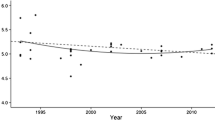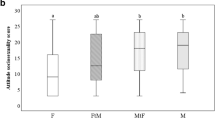Abstract
This study examined the relationship between sex role and gender identity in a Polish transsexual population where, unlike in Western countries, male-to-female (MF)transsexualism is much less common than female-to-male (FM) transsexualism. One hundred and three FM (82 primary, 21 secondary) and 29 MF (16 primary, 13 secondary) transsexuals plus 135 control males (CM) and 303 control females (CF) completed a Sex Role Inventory, which measures sex-role identification, that is, the degree to which one self-identifies with masculine and feminine characteristics. Data obtained from primary transsexuals revealed that, on a femininity scale, MF transsexuals scores exceeded not only CM but also CF. On a masculinity scale, MF transsexuals rated themselves significantly lower than CM, but at a level comparable to CF. The comparison of FM transsexuals and controls showed that, on a masculinity scale, transsexuals scored higher than CF but were not different from CM. On the femininity scale, FM transsexuals rated themselves in between the two control groups: lower than CF but slightly higher than CM. The relations of secondary transsexuals' scores to CF and CM scores, on both masculine and feminine scales, were in the same direction as the primary transsexuals' scores. Secondary transsexuals rated themselves very similarly to their primary counterparts (the exception was a much higher score of MF-primary transsexuals than MF-secondary transsexuals on the femininity scale). Our study revealed that transsexualism does not imply a simple inversion of sex-role patterns: transsexuals differ not only from nontranssexual individuals of the same anatomical sex but also from those of the opposite sex. Moreover, MF transsexualism is not a mirror image of FM transsexualism: it constitutes a more extreme condition in the identification with feminine versus masculine personality traits. These differences seem to be universal for different countries and regions. The diagnostic value of our findings is discussed.
Similar content being viewed by others
REFERENCES
American Psychiatric Association. (1994). Diagnostic and statistical manual of mental disorders (4th ed.). Washington, DC: Author.
Arndt, R., Bosinski, H., & Wille, R. (1995, June). Relationship between gender-identity/role, personality and cognitive abilities. Poster session presented at the biannual meeting of the Harry Benjamin International Gender Dysphoria Association, Kloster Irsee, Germany.
Bailey, J. M. (1996). Gender identity. In R. C. Savin-Wiliams & K. M. Cohen (Eds.), The lives of lesbians, gays, and bisexuals: Children to adults (pp. 71–93). Fort Worth, TX: Harcourt Brace College.
Barlow, D. H., Mills, J. R., & Agras, W. S. (1980). Comparison of sextyped motor behavior in male-to-female transsexuals and women. Archives of Sexual Behavior, 9, 245–253.
Bem, S. L. (1974). The measurement of psychological androgyny. Journal of Consulting and Clinical Psychology, 42, 155–162.
Bem, S. L. (1981). Gender schema theory: A cognitive account of sextyping. Psychological Review, 88, 354–364.
Blanchard, R. (1985). Typology of male-to-female transsexualism. Archives of Sexual Behavior, 14, 247–261.
Blanchard, R., Steiner, B. W., & Clemmensen, L. H. (1985). Gender dysphoria, gender reorientation, and the clinical management of transsexualism. Journal of Consulting and Clinical Psychology, 53, 295–304.
Bodlund, O., Kullgren, G., & Sundbom, E. (1993). Personality traits and disorders among transsexuals. Acta Psychiatrica Scandinavica, 88, 322–327.
Brems, C., Adams, R. L., & Skillman, G. D. (1993). Person drawings by transsexual clients, psychiatric clients, and nonclients compared: Indicators of sex-typing and pathology. Archives of Sexual Behavior, 22, 253–264.
Cohen-Kettenis, P. T., & Gooren, L. J. G. (1999). Transsexualism: A review of etiology, diagnosis and treatment. Journal of Psychosomatic Research, 46, 315–333.
Cohen-Kettenis, P. T., & Wålinder, J. (1987). Sex reassignment surgery in Europe: A survey. Acta Psychiatrica Scandinavica, 75, 176–218.
Collier, M., Cole, D., & O'Boyle, M. (1997). Comorbidity of gender dysphoria and other major psychiatric diagnoses. Archives of Sexual Behavior, 26, 13–26.
Constantinopole, A. (1973). Masculinity-femininity: An exception to a famous dictum? Psychological Bulletin, 80, 389–407.
Docter, R. F. (1988). Transvestites and transsexuals. Toward a theory of cross-gender behavior. New York: Plenum.
Dulko, S. (2000). Incidence and sex ratio of transsexualism in Poland (unpublished manuscript). Medical Centre of Postgraduate Education, Warsaw, Poland.
Fleming, M., Cohen, D., & Salt, P. (1981). A study of pre-and postsurgical transsexuals: MMPI characteristics. Archives of Sexual Behavior, 10, 161–170.
Fleming, M. Z., Jenkins, S. R., & Bugarin, C. (1980). Questioning current definitions of gender identity: Implications of the Bem Sex-Role Inventory for transsexuals. Archives of Sexual Behavior, 9, 13–26.
Fleming, M. Z., MacGowan, B. R., & Salt, P. (1984). Female-to-male transsexualism and sex roles: Self and spouse ratings on the PAQ. Archives of Sexual Behavior, 13, 51–57.
Godlewski, J. (1988). Transsexualism and anatomic sex ratio reversal in Poland. Archives of Sexual Behavior, 17, 547–54.
Hayes, S. C., & Leonard, S. R. (1983). Sex-related motor behavior: Effects on social impressions and social cooperation. Archives of Sexual Behavior, 12, 415–426.
Herman-Jegli?ska, A., Dulko, S., & Grabowska, A. (1997). Transsexuality and adextrality: Do they share a common origin? In L. Ellis & L. Ebertz (Eds.), Sexual orientation: Toward biological understanding (pp. 163–180). Westport, CT: Praeger.
Kinsey, A. C., Pomeroy, W. B., & Martin, C. E. (1948). Sexual behavior in the human male. Philadelphia, PA: Saunders.
Kuczy?ska, A. (1992). Inwentarz do oceny p à lci psychologicznej [Sex role inventory]. Warsaw, Poland: Polish Psychological Association.
Kuiper, B., & Cohen-Kettenis, P. T. (1988). Sex reassignment surgery: A study of 141 Dutch transsexuals. Archives of Sexual Behavior, 17, 439–457.
Landén, M., Wålinder, J., & Lundström, B. (1996). Prevalence, incidence and sex ratio of transsexualism. Acta Psychiatrica Scandinavica, 93, 221–223.
Landén, M., Wålinder, J., & Lundström, B. (1998). Clinical characteristics of a total cohort of female and male applicants for sex reassignment: A descriptive study. Acta Psychiatrica Scandinavica, 97, 189–194.
Lindemalm, G., Körlin, D., & Uddenberg, N. (1987). Prognostic factors vs. outcome in male-to-female transsexualism. Acta Psychiatrica Scandanavica, 75, 268–274.
Lippa, R. A. (2001). Gender-related traits in transsexuals and nontranssexuals. Archives of Sexual Behavior, 30, 603–614.
Lothstein, L. M. (1982). Sex reassignment surgery: Historical, bioethical, and theoretical issues, American Journal of Psychiatry, 139, 417–426.
Meyer-Bahlburg, H. F. L. (1993). Gender identity development in intersex patients. Child and Adolescent Psychiatric Clinics of North America, 2, 501–512.
Pauly, I. B. (1974a). Female transsexualism: Part I. Archives of Sexual Behavior, 3, 487–507.
Pauly, I. B. (1974b). Female transsexualism: Part II. Archives of Sexual Behavior, 3, 509–526.
Ross, M. W., Wålinder, J., Lundström, B., & Thuwe, I. (1981). Crosscultural approaches to transsexualism. Acta Psychiatrica Scandinavica, 63, 75–82.
Shore, E. R. (1984). The former transsexual: A case study. Archives of Sexual Behavior, 13, 277–285.
Skrapec, C., & MacKenzie, K. R. (1981). Psychological self-perception in male transsexuals, homosexuals, and heterosexuals. Archives of Sexual Behavior, 10, 357–370.
Snaith, P., Tarsh, M. J., & Reid, R. (1993). Sex reassignment surgery: A study of 141 Dutch transsexuals. British Journal of Psychiatry, 162, 681–685.
Spence, J. T., & Helmreich, R. L. (1978). Masculinity and femininity. Austin, TX: University of Texas Press.
Storms, M. D. (1979). Sex role identity and its relationship to sex role attribution and sex role stereotypes. Journal of Personality and Social Psychology, 31, 1779–1789.
Sundbom, E., & Bodlund, O. (1999). Prediction of outcome in transsexualism by means of the Defense Mechanism Test and multivariate modeling: A pilot study. Perceptual and Motor Skills, 88, 3–20.
Van Kestercn, P. J., Gooren, L. J., & Megens, J. A. (1996). An epidemiological and demographic study of transsexuals in The Netherlands. Archives of Sexual Behavior, 25, 589–600.
Wålinder, J. (1967). Transsexualism: A study of forty-three cases. Göteborg, Sweden: Scandinavian University Books.
Wålinder, J. (1971). Incidence and sex ration of transsexualism in Sweden. British Journal of Psychiatry, 119, 195–196.
Weitze, C., & Osburg, S. (1996). Transsexualism in Germany: Empirical data on epidemiology and application of the German Transsexuals Act during its first ten years. Archives of Sexual Behavior, 25, 409–425.
Author information
Authors and Affiliations
Rights and permissions
About this article
Cite this article
Herman-Jeglińska, A., Grabowska, A. & Dulko, S. Masculinity, Femininity, and Transsexualism. Arch Sex Behav 31, 527–534 (2002). https://doi.org/10.1023/A:1020611416035
Issue Date:
DOI: https://doi.org/10.1023/A:1020611416035




